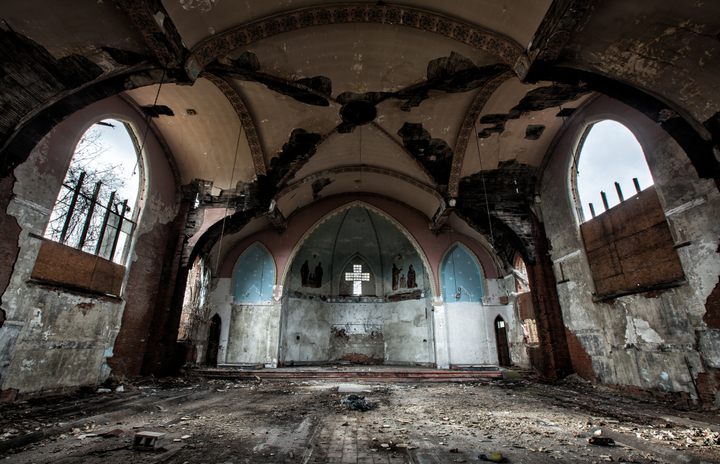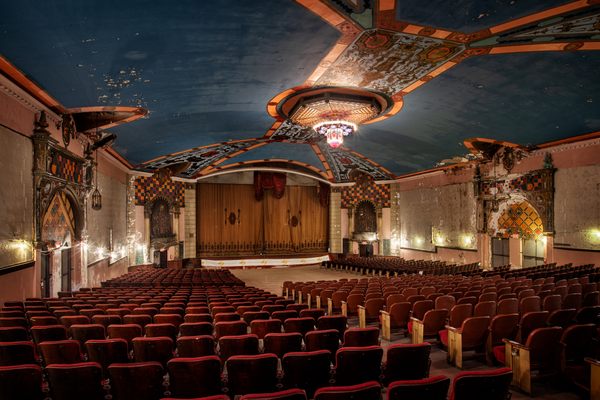
Why Are There So Many Abandoned Churches?
Changing neighborhoods, loss of faith, even heating bills make places of worship among the most common types of forgotten places.

It had been seven years since I first visited the abandoned Ascension of Our Lord Church in the Kensington area of Philadelphia, but I still didn’t expect it to be so far gone. That first time had been in 2014, just two years after the church had closed. Even then the sanctuary was pocked by peeling paint and crumbling plaster—telltale damage from roof leaks and a lack of climate control—but the beautiful altar, with its statuettes of kneeling cherubs, was intact. The pews and ornate light fixtures were all in place, and there was still a faint hope that it could be renovated with a little luck and the right new owner. It might not be a church anymore, but maybe it could have a future as a restaurant, nightclub, or apartments. Anything would do, if it could preserve some of the majestic architecture.
The years between 2014 and my return in 2021 had not been kind to the Roman Catholic Church or its neighborhood. A traditionally working-class neighborhood, Kensington had become known as the “Walmart of Heroin,” and for a significant unhoused population, subjects of exposés in The New York Times Magazine and Time. Dedicated in 1900 and once the third-largest parish in the city, it hosted so many squatters suffering from addiction that a visiting priest from the nearby Mother of Mercy House outreach program remarked to Catholic Philly that “it looked like they were waiting for Mass to start.” In the frigid winter of 2017, some of them started a fire inside the church for warmth, and it rapidly grew out of control. The two-alarm blaze was extinguished without any serious injuries or catastrophic damage to the nave, but other areas of the building had not fared so well. As I gingerly made my way through what remained in 2021, I saw feces and used condoms in the confessionals, and needles littering the floor. I picked up a photograph of what appeared to be the face of a young, sleeping man, until I realized he was not on a bed but in a casket. A salvage crew had tossed wood from the broken pews and floors out holes in the windows. All that was left of the altar was a pile of bricks and rubble.


The story of every abandoned church is different, but there are themes: changes in neighborhood demographics, dwindling attendees and funds, aging structures, and poverty chief among them. The broad strokes of Ascension’s story aren’t that different from those of many urban churches. In parts of a city like Pittsburgh, for example, you could easily find six churches in a two-block radius, each built to serve its own ethnic population. On one corner you might have a German church, Polish or Irish catty-corner, Slovakian on the next block. Assuming they were all Catholic—and many were—mass and hymns were offered in native languages, and they often served as nexuses of integration and social support for fast-growing immigrant communities.
The buildings themselves reflected the trades and values of their attendees, with a mix of locally quarried stone and embellishments imported from home. With the postwar exodus to the suburbs and the cratering of industrial economies in many regions, churches struggled to attract people. In Kensington, with the rippling closures of its factories—dye plants, tanneries, meat-processing facilities, a Stetson Hat factory, and a staggering 126 textile mills—incomes plummeted as well. In 1970, 16.4 percent of the households in the North District, which includes a large portion of Kensington, were below the poverty level. By 2015, it was 45.4 percent, according to a report from the nonprofit City Center District. Churches consolidated and merged, but it wasn’t enough to keep up with costly, necessary repairs.

These local factors are compounded by a nationwide shift away from organized religion, schisms among the remaining churchgoers, and accusations of sexual abuse. Today, roughly a third of American adults claim to have no religious affiliation, with the number closer to 50 percent among younger generations. The Hartford Institute for Religion Research reports that between 2000 and 2020, median attendance at church services dropped from 137 to 65. More Protestant churches closed than opened in 2019, and things only got worse during the pandemic. Churches also have increasingly found themselves caught in the political crossfire, over issues such as LGTBQIA+ inclusivity and overt support of political candidates—often along generational lines. In a particularly bitter irony, Christian churches, whose core tenet is the worship of a man who spent his early childhood as a refugee fleeing persecution, have found themselves angering congregants regardless of whether they support or condemn immigration today. Rifts due to political beliefs are nothing new—in fact, they have often given rise to new denominations. But with a shrinking pool of congregants, branching off may not be an option. Where a split might once have created two churches, now it might leave none.
As someone whose goal is to document vanishing historical sites rather than pass judgment on them, I do my best to leave my own faith—or, rather, lack thereof—out of my examinations of the decaying sites I visit. Every abandoned building comes with scandals or baggage, but also positive memories, and my job is to chronicle both. As more religious sites wind up in advanced states of abandonment and, eventually, in landfills, I can’t help but marvel at the waste. Some people, when faced with photos of an abandoned church, lament society’s loss of faith. Others can’t wait until all churches meet the same fate. But both sides often miss the fact that churches can serve as irreplaceable repositories of the art and history of their communities. For example, in one small Pennsylvanian coal community’s church, I couldn’t help but notice that the altar incorporated anthracite coal slabs etched with reliefs of pickaxes, shovels, and a miner’s headlamp. The locally quarried stone and old wood in churches that had been built to last centuries is, in most places, exhausted now. The very trades that were essential to the construction of a traditional church—woodwork, stonework, weaving, stained glass—are on the decline, too. Next to homes, churches are now perhaps the most pervasive type of abandoned location in America, and their numbers present a problem for which the most frequent solution is demolition.

Churches present unique challenges for repurposing—often the best option for saving a historic, abandoned building. Their spaciousness and high ceilings make heating and cooling expensive, and the materials and skills required to repair them can be prohibitively expensive. That doesn’t mean there aren’t success stories: vacant churches that have become offices, bookstores, bars or restaurants, even skate parks. Some organizations, such as Partners for Sacred Places, are fighting to support existing congregations and encourage adaptive reuse plans. Funding and entropy will always be obstacles, though.
For the moment, the Ascension of Our Lord Church still stands, its entrances boarded or bricked up, stripped of ornamentation but not memories. In 1923, Father Casey convinced Babe Ruth to play on Ascension’s softball team against Lit Brothers Department Store. Ascension’s summer carnival in 1905—with vaudeville performances, the newfangled luxuries of electric lighting, an automobile to tour the neighborhood in, and moving picture shows—was described in the Philadelphia Inquirer as one of the “most varied and novel of its kind” ever held in the city. Babies were baptized, marriages were celebrated, and people like the young man in the photo I found were mourned. One day, perhaps, when property values in the neighborhood rise enough to encourage redevelopment, perhaps even gentrification, which has occurred in adjacent neighborhoods, Ascension will be torn down. It’s likely too broken to find a second life. Until then, it will continue its slow, quiet descent into the faded realm of lost places, the memories of its festivals and funerals scattered farther and farther in both time and space. I can’t save many of the places I visit with stories and photographs. Sometimes all there is left to do is share a few silent moments, and do my best with words and camera to ensure that their memory doesn’t slip away entirely.



For more photos and history of Ascension visit the gallery on Abandoned America, and for more about the loss of faith-based structures in our midst listen to this episode of the Abandoned America podcast.
Matthew Christopher is a writer and photographer who has explored abandoned locations across the globe for two decades, chronicling the lost landmarks in our midst. You can find more of his work on his website Abandoned America or listen to his Abandoned America podcast.






















Follow us on Twitter to get the latest on the world's hidden wonders.
Like us on Facebook to get the latest on the world's hidden wonders.
Follow us on Twitter Like us on Facebook